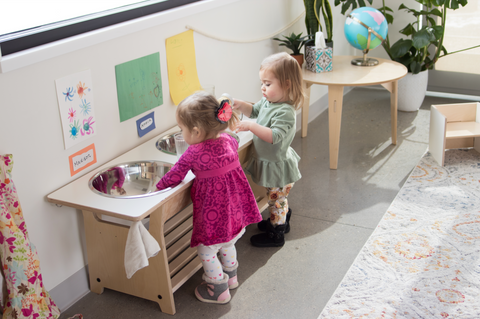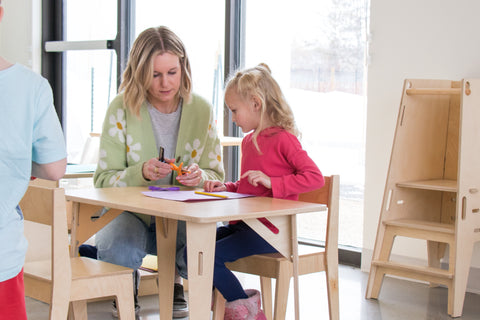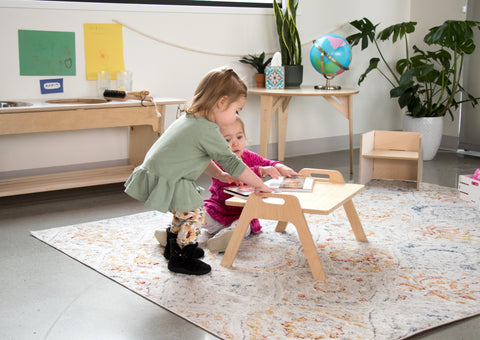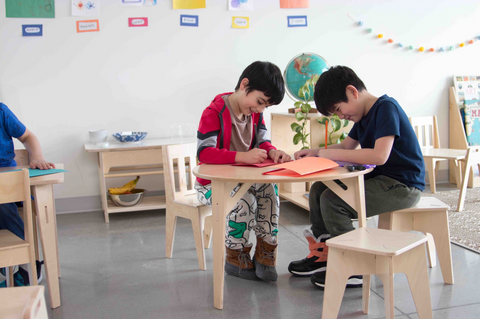
Choosing a Montessori School: What Questions to Ask
Choosing a Montessori School: What Questions to Ask
If you are considering Montessori as a schooling option for your little one, it can be hard to know whether a school offers an authentic approach to Montessori education as “Montessori” is not trademarked or copyrighted. When touring schools, it can be helpful to ask specific questions to understand what classrooms at that school are like.
We asked our community what things they would ask or wished they had asked when they toured a school. These are some questions that you might consider asking if you live in an area where you have multiple Montessori schools to choose from, or if you just want to know how closely a school follows Montessori philosophy and pedagogy.
Questions to Ask a Montessori School
Is there one lead teacher and assistant in every room? What is the student-to-teacher ratio?
In Montessori environments, there is a Montessori-trained lead teacher and an assistant in each classroom. Classrooms with only one teacher don’t allow for the lead teacher to give individual lessons while the assistant teacher is available for the other students. Classrooms with more than two adults in the room at a time generally do not follow Montessori student-to-teacher ratios. In true Montessori environments, there should be no more than 2 adults for a group of 12 toddlers and a group of 20-28 preschoolers. This is intentional! When there are fewer adults available to tend to children’s needs, they learn to rely on each other for help and to wait for an adult to become available.
Are all lead teachers certified for the age group they’re teaching?
The two main certifying organizations for Montessori teachers are the Association Montessori Internationale (AMI) and the American Montessori Society (AMS). These organizations certify teachers for age groups of 0-3, 3-6, 6-12, and 12-18. Ideally, the lead teacher in a Montessori classroom has an AMI or AMS certification for the age group they are teaching.
The Montessori Accreditation Council for Teacher Education (MACTE) is another certifying body that accredits Montessori teacher training institutes. If lead teachers are not AMI or AMS trained, you can inquire if their Montessori teacher training was from a MACTE-certified institute.
Are there mixed-age classrooms?
In Montessori environments beginning at the preschool level, children of different ages are in the same classroom together in 3-year age spans. (Infant and toddler environments span about 1-1.5 years.) This means that children aged 3-6 are together, then they move up to a classroom with 6-9 year olds, then 9-12 year olds, and so on. This is so that children have the experience both of being the youngest learning from older children and being the oldest teaching younger children. This experience repeats itself throughout a child’s experience in Montessori school if they continue to a Montessori elementary program. Mixed-age classrooms also allow for children's individual social and academic benchmarks to be reached on their own timeline, without the constraints of strict age-based standards.
How long is your uninterrupted work period? Is there a daily rhythm that is followed?
A three-hour uninterrupted work period is the hallmark of a Montessori environment for the preschool age group and older. This allows children to fully immerse themselves in work that is freely chosen, without feeling the constraints of scheduled activities like circle time or special classes. Many schools also have the resources and ability to allow children to work in an outdoor area during the work period. In addition, due to the nature of mixed-age classrooms, there are very few activities that will be developmentally appropriate for every child, and therefore Montessori environments have few “required” full-group activities. It is more in line with Montessori pedagogy to offer small group gatherings of 3-8 children throughout the work period, and not require that any children stop what they are engaged in to join the group.
How often is each child observed?
Observation is how Montessori teachers study each child’s development and make plans for their academic progress. By taking the time to observe, teachers can learn about what each child’s interests are and what skills they are currently working on mastering. Then, teachers can plan what lessons to present next that will offer just the right amount of challenge.
How are diverse cultures highlighted and celebrated?
Regardless of what the ethnic and cultural makeup of the classroom is, authentic Montessori environments seek to highlight and celebrate diverse backgrounds and experiences. Asking this question may help give you insight into how the school approaches diversity and equity, and if it is in line with what your family is looking for in a school.
What is your teacher turnover rate? How many teachers have been at the school for multiple years?
This information will give you insight into how supported a school’s teachers feel, and how much consistency there will be for your child. While some teacher turnover is to be expected, in the ideal model, children will be with the same teaching team for all three years in a Montessori environment.
What is your approach to discipline?
To be in line with the Montessori philosophy, a respectful or positive discipline approach should be taken. This means no time-outs, no rewards or punishments, and no sticker charts! The positive discipline approach assumes the best of children and treats them with respect. It is a collaborative approach in which adults work together with children to help them develop self-control and an understanding of the limitations of the environment.
Making a Decision
Multiple Montessori schools, or even multiple preschools, are things that not every geographical location offers. If you do have the opportunity to consider and tour multiple Montessori schools, asking in-depth questions about how the school’s approach aligns with Montessori philosophy and pedagogy can give you insights into whether it is a good fit for your family's needs.
It is important to recognize, however, that you may not find everything you’re looking for in one school. The most important thing is that you are comfortable with the school and feel that it aligns with your family's values.
If you are happy and confident in the school you’re sending your child to, they will become happy and confident in the environment as well.
Have you toured a Montessori school? What questions did you ask?




